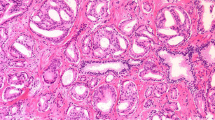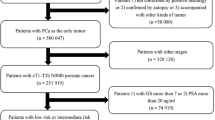Purpose:
The aim of this study is (1) to develop a new method of risk classification for clinically localized prostate cancer; (2) to examine it in terms of compatibility with existing data such as nomograms; and (3) to compare it with existing risk-grouping methods.
Material and Methods:
The new grading system introduced here consists of three factors. The first is a prostate-specific antigen (PSA) of 4.1–10.0 ng/ml (score 0), 10.1–20.0 ng/ml (score 1), and > 20.0 ng/ml (score 2). The second is a Gleason score (GS) of 6 (score 0), 7 (score 1), and 8–10 (score 2). The third is T classifications (UICC 2002) of T1c–T2a (score 0), T2b–T2c (score 1), and T3a (score 2). The sum of the three scores was named Prostate Risk Index (PRIX). Then, the compatibility of PRIX with the Partin Table, Kattan Nomogram, and Roach's formula was examined. At the same time, PRIX was compared with D'Amico, the National Comprehensive Cancer Network (NCCN), and Seattle classifications.
Results:
PRIX 0 corresponded to 1–2% of pathologic lymph node involvement (pLN+) according to the Partin Table; PRIX 1 to 3–4%; PRIX 2 to 7–10%; PRIX 3 to 14–18%; PRIX 4 to 24–29%; PRIX 5 to 32–37%; and PRIX 6 to 42%. PRIX well separated the risks with relatively narrow ranges of probability, while D'Amico, NCCN, and Seattle classifications generally gave wide ranges especially for high-risk groups, both in the Partin Table and Kattan Nomogram. Roach's formula sometimes overestimated the risk compared to the Partin Table.
Conclusion:
PRIX fully corresponded to the Partin Table in terms of pLN+, and corresponded to the other nomograms better than any existing risk-grouping method. PRIX may thus function as a prognostic factor or contribute to patient selection in clinically localized prostate cancer.
Hintergrund und Ziel:
Ziel dieser Studie ist es, 1. eine neue Methode der Risikoklassifikation für klinisch lokalisierten Prostatakrebs zu entwickeln, 2. diese auf ihre Kompatibilität mit bereits vorhandenen Daten wie Nomogrammen hin zu untersuchen und 3. sie mit bestehenden Methoden zur Einteilung in Risikogruppen zu vergleichen.
Material und Methodik:
Das hier vorgestellte, neue Einstufungssystem besteht aus drei Faktoren. Der erste Faktor ist ein prostataspezifisches Antigen (PSA-Wert) von 4,1–10,0 ng/ml (Wert 0), 10,1–20,0 ng/ml (Wert 1) und > 20,0 ng/ml (Wert 2). Der zweite Faktor ist ein Gleason-Score (GS) von 6 (Wert 0), 7 (Wert 1) und 8–10 (Wert 2). Der dritte Faktor sind die TNM-Klassifikationen (UICC 2002) von T1c–T2a (Wert 0), T2b–T2c (Wert 1) und T3a (Wert 2). Die Summe dieser drei Werte wurde Prostata-Risiko-Index (PRIX) genannt. Anschließend wurde die Kompatibilität des PRIX mit den Partin-Tabellen, dem Kattan-Nomogramm und der Formel von Roach untersucht. Gleichzeitig wurde PRIX mit den Klassifikationen von D'Amico, dem US-amerikanischen Krebs-Netzwerk (NCCN) und Seattle verglichen.
Ergebnisse:
PRIX 0 entsprach einem pathologischen Lymphknotenbefall (pLN+) von 1–2% laut Partin-Tabellen, PRIX 1 von 3–4%, PRIX 2 von 7–10%, PRIX 3 von 14–18%, PRIX 4 von 24–29%, PRIX 5 von 32–37% und PRIX 6 von 42%. PRIX unterschied die Risiken sehr gut mit relativ engen Wahrscheinlichkeitsspannen, während die Klassifikationen von D'Amico, NCCN und Seattle in der Regel weite Spannbreiten hatten, insbesondere für Hochrisikogruppen sowohl in den Partin-Tabellen als auch im Kattan-Nomogramm. Die Formel von Roach bewertete gelegentlich die Risiken im Vergleich zu den Partin-Tabellen zu stark.
Schlussfolgerung:
PRIX stimmte in Hinblick auf den pLN+ vollständig mit den Partin-Tabellen überein und entsprach den anderen Nomogrammen besser als jede andere vorhandene Methode zur Klassifizierung von Risikogruppen. PRIX könnte daher als prognostischer Faktor dienen oder zur Patientenselektion bei klinisch lokalisiertem Prostatakrebs beitragen.
Similar content being viewed by others
Author information
Authors and Affiliations
Corresponding author
Rights and permissions
About this article
Cite this article
Yoshioka, Y., Inoue, T. Prostate Risk Index (PRIX) as a New Method of Risk Classification for Clinically Localized Prostate Cancer. Strahlenther Onkol 183, 490–496 (2007). https://doi.org/10.1007/s00066-007-1692-3
Received:
Accepted:
Issue Date:
DOI: https://doi.org/10.1007/s00066-007-1692-3




